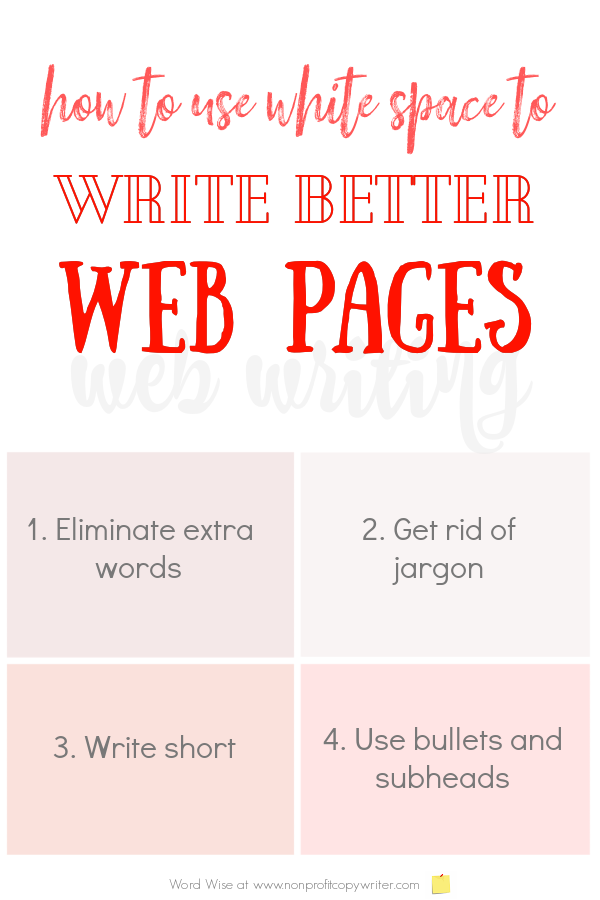Save Time: Get 5 Simple Writing Tips
you can put to use in 10 minutes
3 Simple Tips for Writing Better Web Pages
Award-winning writer Kathy Widenhouse has helped hundreds of nonprofits and writers produce successful content , with 750K+ views for her writing tutorials. She is the author of 9 books. See more of Kathy’s content here.
Updated 4.25.24
Think about how you read web pages. You’re usually looking for information, right? Take this page, for instance. You’ve been promised three tips. Right about now, you’re scrolling down to skim for those three points. If they intrigue you, you’ll read more.
A good web writer considers how to help readers get what they came for when they land on your website.
Tip #1: Place important information first
If you get nothing else from this page, understand this about website content writing: place your key ideas near the beginning of the page.
Also known as inverted pyramid writing, this approach is used by writers and journalists in traditional media. Essential details are presented first, often as a summary, allowing readers to find out the basics from the opening few paragraphs. The rest of the article gives in-depth information and additional details.
Translation to writing web pages: summarize your page’s content somewhere in the first 100 words – preferably in the first 50 words.
Do this by using keywords. Know what keywords (or key phrases) you want to communicate on that particular page and then strategically place those keywords at the top and in subsequent subheads.
Which leads to the next of these 3 simple tips for writing pages for the web …
Tip #2: Use white space
Web readers skim. They don’t read word for word. Forget what you learned in English class about presenting ideas in 3-sentence paragraphs.
As you write content for your web page, know that less is more. One sentence equals a paragraph.
You can work in more white space onto your web content when you …
- Eliminate extra words. Write in a clear, concise style. Use only as much information as needed to communicate the point of the page. If your reader needs more information to understand a concept, link him to another page (See Tip #3, below).
- Eliminate jargon. Forget insider lingo and fancy language that you think makes you sound smart. Readers respect you more when you write in plain English. Remember, they’re on your website to get information … not to be intimidated.
- Write short sentences and paragraphs. One- or two-sentence paragraphs work best on the web.
- Use bullet points and subheads. These visual reminders give the reader the “high points” and guide him through your piece to give him the gist of what you’re saying. (Here are some tips for writing better bullet points)
Tip #3: Include internal links
Internal links (that is, links to other pages on your website) allow your reader to find related content on your site. Links also help search engines to crawl your site – a good thing to gain you more traffic. (Links to other sites will take readers away from your page. Some outbound links are good to provide helpful information, but in most cases you want reader to stay on your site as long as possible.)
Without internal links, each page of your website is isolated. Your readers won’t know about all the other useful content you’ve got available to them.
Internal links also allow you to write tight (see Tip #2). Rather than explain a point in detail and get off topic, you can create a contextual link to another page on your site that addresses the issue. Your page content will stay on point.
Which in this case, was to give you 3 simple tips for writing better web pages.
More Web Writing Tips
12 Tips for Writing Website Content That’s Easy to Read ...
The 3 Types of Links Your Website Needs and How to Build Them ...
How to Build a Content Writing Strategy for Your Blog or Website ...
The 6 Pages You MUST Have on Your Writing Website ...
3 Things You Need for Planning a Website (or Updating One) ...
Make a P-L-A-N for Your Website Content Writing ...
Writing Content For a Website: Write These 3 Pages First ...
The Top Online Copywriting Tip ...
Review: Website Hosting with SBI (Solo Build It) ...
3 Tips for Writing Homepage Content: A Quick Tutorial ...
10 Writing Tips for Your Website About Page ...
3 Tips for Writing Conversationally Online (and Off) ...
How to Write More Powerful Lead Magnets: 5 Easy Steps ...
Terms You Need to Know for Writing Website Content: A Glossary ...
How to Get Your Website Noticed: a primer ...
What Your Website Homepage MUST have ...
Nonprofit website checklist: 10 items you need on your website template
Web Writing: How It Is Unique ...
More writing tips for your web page on our Pinterest board
Return from Writing Better Web Pages to Nonprofit Copywriter home
As an Amazon Associate I earn from qualifying purchases.
Share This Page

Named to 2022 Writer's Digest list
BEST GENRE/NICHE WRITING WEBSITE


Stop Wasting Time!
Grab your exclusive FREE guide, "5 Simple Writing Tips You Can Put to Use in 10 Minutes or Less"














